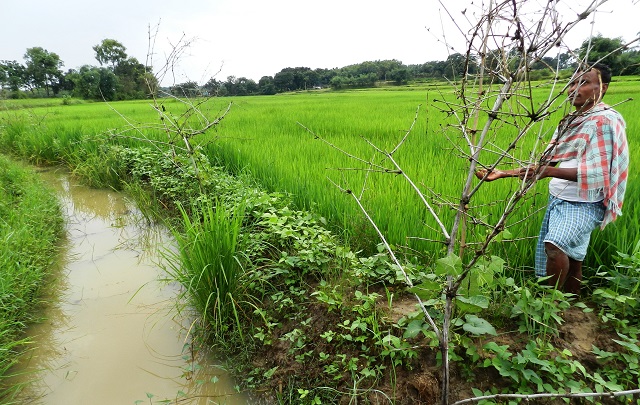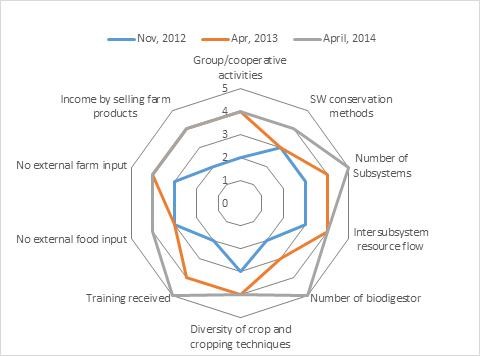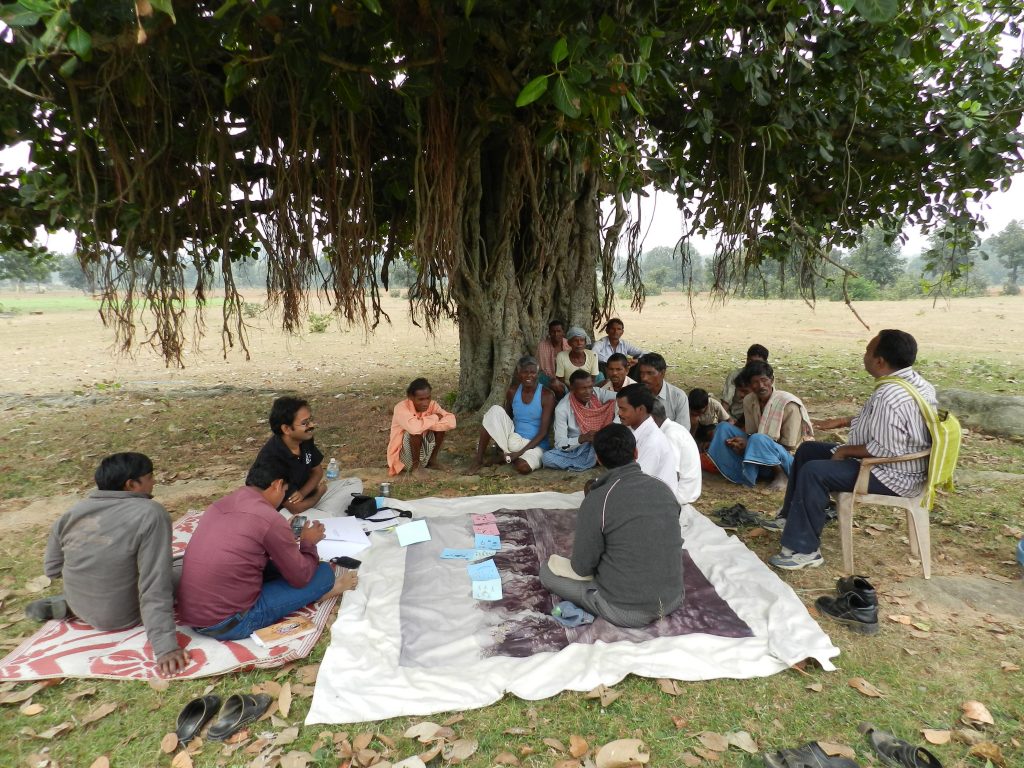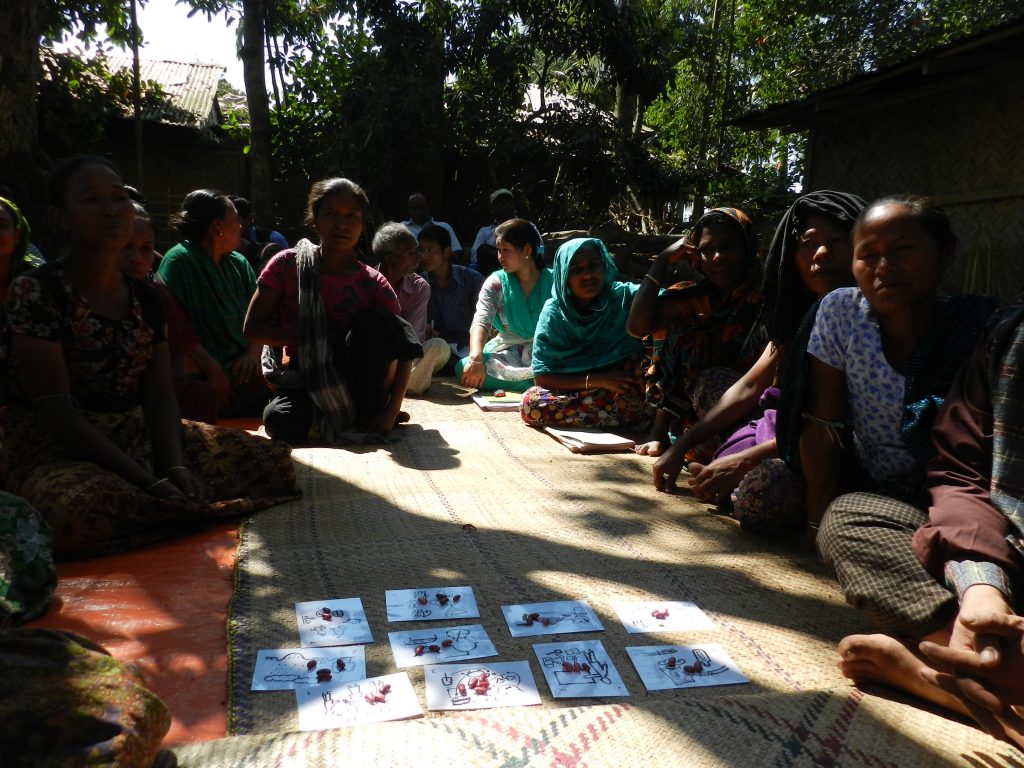
Agro-ecology, as I understand is complex, but not complicated. When I look into a forest, I find it is a complex network of food chains with overlapping food webs. But, it is also simple as it is designed with a very basic fundamental principle – principle of collaboration – collaboration between species, and collaboration within species, so that there is a balance in population and a balance between energy inflow-outflow. To bring in that collaboration, the design of a forest is multistoried, both above and within the soil. It is so well-designed that, if it is not influenced by any external change or change agent, the overall productivity of a forest is far better than any agriculture production system designed by us.
Agro-ecology is closer to a natural system which imbibes the principles of nature – collaboration, recycling, multi-layered arrangement, a combination of various species/varieties and allowing succession.
The BIOFARM project, which was scaled up through Sustainable Integrated Farming System (SIFS) project among 9500 farms in India, Nepal and Bangladesh tried to promote sustainable agriculture by promoting the following three agro-ecological principles.
- Altering cropping sequence through mixed/inter/relay cropping for collaboration and combination. Crop rotation for allowing succession and collaboration.
- Creating multi-layered space within a production system, so that collaboration and recycling are ensured.
- Enhancing subsystem diversity on farm, so that energy recycling and collaboration happens by default.
The challenge of measurement
Economics has a very straight understanding of production relation. Calculating production and productivity is very simple, if we consider only yield as a beneficial output of a crop, say paddy crop. On the other hand in agro-ecology, apart from paddy as an output, we see the benefits of straw as fodder/thatching/mulching, husk as fodder/fuel, roots that add humus to the soil, edible water weed/shrimps/crabs/small fishes from the rice field as food. Also, paddy field plays an important role in recharging ground water. Therefore, we need to have a different set of parameters to capture impact of an agro-ecological system.
So, how do we calculate the productivity? How will the ecological role that the paddy crop plays in improving water aquifer or in biodiversity conservation? Our analytical framework can’t assess cropping intensity of a garden, which has more than 40 types of crops, providing food every day, throughout the year. We do not have indicators beyond N, P, K and organic carbon to measure soil health. We can’t comment on health of a farming system as a whole – as it is probably too complex for a mathematical equation.
The BIOFARM project tried to assess the efficacy of the method in terms of assessing the changes in social, ecological and economical parameters. Three years were too short a time to establish the hypothesis but it shows the direction of the trend. It was tried through community monitoring and through analysis of data.
| Agroecology is considered to be a climate adaptive practice as it reduces dependency on climate dependent income source, hence reducing vulnerability. |
Measuring returns
Community monitoring is an already established way of tracking progress of any action and to do mid-term corrections. In addition, setting a target is always helpful to ensure that one keeps going in the right direction. Keeping this in mind, a tool based on the wheel diagram was developed to help small farmers following agroecological principles, to set their own target and monitor it. The Wheel helps in visualizing and comparing multiple ratings/scoring. A set of ten parameters were developed.
- Group/cooperative activities: Extent to which farmers are active in groups, cluster groups, common activities and joint action like farming in common land etc. In case of a group, the criteria refers to the health of the whole group.
- Soil water conservation methods adopted: How soil water conservation methods are integrated in the farm – eg., field bunds, rainwater harvesting, mulching, compost use, semi-circular bunds, zero tillage farming, diamond bed, double digging bed, pitcher irrigation, circle bed etc.
- Number of subsystems: The number of subsystems (biodigestor, poultry, livestock, trees, crops, aquaculture) owned by the farm.
- The inter sub systems resource flow: The number of linkages (indicating integration) between the various subsystems.
- Number of biodigestors: This includes for example biogas plant, vermicompost pit, compost pit, use of liquid manure, farm yard manure and green manure.
- Diversity of crop and cropping techniques: Gradation of the farm in terms of the diversified crop elements present – Crops may include fruit type, legumes, leafy vegetables, cereals, medicinal herbs, tuber crops, spices etc. Cropping techniques include mixed cropping, intercropping, crop rotation, relay cropping etc.
- Training received: Types of training a farmer received during an yearlong training approach through Farmer Field School. Broadly, the skills covered are : 1) analysing stress, livelihood cycle, resources, capacities and correspondingly planning an own farm model 2) various soil nutrient management methods 3) water management methods 4) horticultural component in the homestead and field 5) backyard poultry management including feed 6) small livestock management including fodder 7) pest/disease management of crops/livestock throughout the growth stages 8) soft skills on group development and value chain.
- External food input: Quantity of the external food input (vegetables, proteins – everything that is required for a balanced diet) bought from the market.
- External farm input: Quantity external farm inputs (including seed) bought from the market.
- Income by selling product: Measurement of ‘how far cash need is met from market linkage income’ – distress selling is not taken into consideration.

For each criteria (which were given as a set of 10 pictorial cards), farmers are supposed to give a score from 0 to 5 (low to very high) and add it to the web in the diagram. The same was repeated in 6 months. It was observed that there was a lot of discussion and debate during the scoring part, which is the most important part of the exercise. Many shortcomings and successes were pinpointed as reasons behind that scoring, thus helping in planning for the future course of action. This was tried at two levels – at the group level and at an individual farmer level.
Farmers were also capacitated to keep regular record of farm activity, input and output – which was analysed later on. It also had calculation of net income and other standard parameter, but we focused on the parameters which can assess the aspects of agro-ecology of a farm. Jharkhand refers to farms in Deoghar and Ranchi district, West Bengal refers to Birbhum, Bankura and Purulia district and Hilly region refers to Chitwan in Nepal and Chitagong Hill Tracts in Bangladesh. The results are discussed below.
Measuring farm diversity
Diversification is considered as the most important phenomena in an agro-ecological farm. The subsystem diversification signifies that the source of income diversifies along with the time of income throughout the year – compared to concentration of income depending on one crop, once a year. The subsystems were cropland, garden, poultry, livestock, aquatic systems, biodigestor, forest/commons, tree, group business of value addition etc. It shows the subsystem diversity was 3.5 on an average (range 3 to 4.5) which steadily increased to 8 in case of West Bengal, where water probably played a major role and stabilized to 5 subsystems as a source of income/biomass in case of Jharkhand and Hilly region. This is also true in Rabi season. Summer, which generally remains fallow, has also shown biomass output from 2.54 sources on an average from 2014 onwards. The implication of this has reflected in 45% of the farms recording the growing season being extended to 3 from 1 in the baseline in Jharkhand. While it is 89% in the hilly region, it is 60% in case of West Bengal. More than 2 subsystems noted growing excess biomass for market as well, in general.
Income distribution
Having more than one subsystem has also affected the distribution of income pattern. As noticed 65 to 85% of the income of the family from the farm used to come from crops and vegetables – which are dependent on monsoon directly. But within 3 years, the intervention has reduced dependency of the family on the climate dependent source, by creating space for livestock, poultry, aquaculture and others. For example, in Hilly area in 2012 Kharif season, the distribution of income was as follows – 32.26% from the crop, 13.12% from vegetables, 19.77% from livestock, 1.32% from poultry, 14.91% from aquaculture and 18.60% from value added products. With time, livestock and poultry have more potential to grow. In West Bengal, aquaculture plays a major role in income generation – as high as 34%. This is one of the reasons, why an agroecology is also considered to be a climate adaptive practice as it reduces dependency on climate-dependent income source, hence reducing vulnerability/risk.
With limitation of data, no correlation could be established between income enhancements with increased number of subsystems, but distribution of income has noticed to be more evenly distributed over the year, so cash availability throughout the year has also increased.
Whereas the major crop diversity changes to minimum 2~3 to maximum 4~5 in the crop land, the home gardens seems to be more diverse with 6~7 on an average. Crops grown are mainly cereals like rice/wheat/finger millet; pulses like black gram/lentil oilseeds like niger/mustard/ flack seed and vegetables like potato/mixed vegetables – which are grown in larger patch. This has a big impact in diet diversity (referred later) which is highest in case of Hilly area followed by West Bengal. Apart from quality of food, diversity also affected quantity as mixed diverse product has been grown in permanent and seasonal fallow. Six hundred and fifty hectares of fallow land has been converted to crop land and 850 ha of single crop area converted to double crop. Pulses were given preference in transforming the character of the land.

A community monitoring session in Deoghar
Diet diversity
Diet diversity score was done in Jharkhand India in 2014, which showed that about 70% women are eating at least 5 food groups – Beans and Peas, nuts and seeds, dairy products, eggs and fruits, vegetables and leafy vegetables. At the beginning year, 2011 – the majority households were consuming mostly starchy staples. Being a vegetarian dominated state, the progress is remarkable.
Inter-subsystem linkages, which reflects energy/biomass flow between the subsystems, within the entire farming system indicates the closeness and efficiency of a system.
Generally, more the number of linkages, more efficient the system is. The average linkage, which was little more than 1 in 2011, has gradually become nearly 8 in 3 years, where maximum incident was of 12. The results are better in case of West Bengal, probably because of the community which comprised of farm families. In hilly areas it shows comparatively poor results, probably owing to plenty of biomass availability in the wild, for which farmers do not need to create linkages for increasing availability of biomass. But the recycled amount of biomass is showing increasing trend with the increase of number of linkages – though it varies location wise. The average amount of biomass recycled within the subsystems in a farm in 2015 Kharif was 7738 Kg. During the BIOFARM project earlier, we also used the flow of energy in terms of calories – but we tried to keep it simpler this time, so that it is easily understandable.
This recycling is helping in reducing the use of external inputs. It is noticed that the biomass recycling is better during Kharif season – and best in case of West Bengal. During baseline, the community was recycling biomass only in terms of collecting cow dung from the cowshed. The definition of biomass has been extended during the project to include crop wastes, livestock dung, urine, feaces of poultry, crop residues, weeds etc. The processes involved were heap and pit composting, bio dung preparation, NADEP composting, vermicomposting, liquid manure preparation, mulching etc. If this amount of biomass was not recycled, either it would have to be bought from outside, or the farms would have faced shortages.
In Jharkhand, 35% of the farmers had less than 50% farm input coming internally in 2012, which reduced to 12% in 2013 (Table 1). There was a gradual shifting towards self-sufficiency with 5% farmers using more than 90% of inputs produced on the farm. West Bengal farms showed better results, corresponding with the higher number of links and higher biomass recycled. It is evident that farmers are moving towards self-sufficiency, though there is still huge scope for improvement.
Table 1: Extent of external input usage
| % of farm inputs produced on farm | ||||||
| >90% | >80% | >70% | >60% | >50% | <50% | |
| % farmers in | ||||||
| Jharkhand 2012 | 0.00 | 4.17 | 20.45 | 22.88 | 16.86 | 35.64 |
| Jharkhand 2013 | 5.26 | 13.23 | 22.27 | 30.78 | 15.53 | 12.93 |
| Hilly Region 2012 | 0.00 | 0.00 | 8.33 | 20.83 | 25.00 | 45.83 |
| Hilly Region 2013 | 12.36 | 12.36 | 15.73 | 6.74 | 7.87 | 44.94 |
| West Bengal 2012 | 46.67 | 11.67 | 6.67 | 8.33 | 10.00 | 16.67 |
| West Bengal 2013 | 93.33 | 0.00 | 3.33 | 3.33 | 0.00 | 0.00 |
Increased food self sufficiency
From the food security aspect, as most of the farm families were in the food insecurity level, the challenge was to take them to sufficiency level and promote them to surplus level. In 2013, 48% farmers were at surplus level.

A community monitoring session in CHT, Bangladesh
Biomass productivity
Productivity, as it is described classically, is of a single crop. The Integrated Farming System (IFS) considered biomass productivity of the entire farm including food that went for self-consumption/market, fodder, fuel and biomass that is recycled. Rabi in Hilly regions (12000 Kg/ha in 2013) and Jharkhand (9000 kg/ha in 2013) has shown better results, whereas Kharif shows better result in West Bengal (8100 kg). An interesting trend of land biomass productivity is noticed where it is reduced in 2013 from 2012. The probable reason is, less fallow as fallows contains high amount of unused biomass.
Some constraints
Owing to lack of authentic data, it was difficult to calculate the labour productivity in terms of time spent for production activities by the family. But it was evident by case by case analysis that agro-ecological farming is labour intensive and often it increases pressure on women members of the family as it includes livestock management in farming. So gender sensitiveness has to be brought into the entire plan. It involves family members in productive labour days in their own farm rather than working outside the farm as a labour. Most of the farmers, who have been successful, have described the labour intensiveness as positive, giving similar logic.
Changing mindsets
Measuring the impacts of agro ecology over several parameters of different kind, beyond income, infact helped farmers realize the various benefits that they could realize by diversifying their farm enterprises. By building their capacities to record and analyse different parameters or indicators, helped farmers positively in influencing their mindsets in moving towards more diversified farming systems from a highly focused monocropping of paddy. Those who maintained diaries, monitored their farm progress are continuing with the principles. Demystifying data which encourages the farmer to participate in the collection, analysis and understanding, is probably the key to moving from farm to farming systems.
*The article was originally published on leisaindia.org and can be accessed at http://leisaindia.org/articles/farm-to-systems-where-is-our-measuring-tape/




